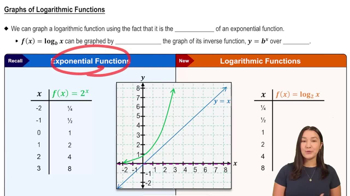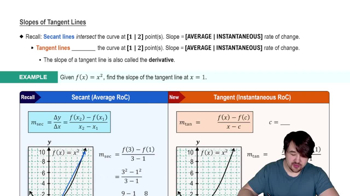Table of contents
- 0. Functions7h 52m
- Introduction to Functions16m
- Piecewise Functions10m
- Properties of Functions9m
- Common Functions1h 8m
- Transformations5m
- Combining Functions27m
- Exponent rules32m
- Exponential Functions28m
- Logarithmic Functions24m
- Properties of Logarithms34m
- Exponential & Logarithmic Equations35m
- Introduction to Trigonometric Functions38m
- Graphs of Trigonometric Functions44m
- Trigonometric Identities47m
- Inverse Trigonometric Functions48m
- 1. Limits and Continuity2h 2m
- 2. Intro to Derivatives1h 33m
- 3. Techniques of Differentiation3h 18m
- 4. Applications of Derivatives2h 38m
- 5. Graphical Applications of Derivatives6h 2m
- 6. Derivatives of Inverse, Exponential, & Logarithmic Functions2h 37m
- 7. Antiderivatives & Indefinite Integrals1h 26m
- 8. Definite Integrals4h 44m
- 9. Graphical Applications of Integrals2h 27m
- 10. Physics Applications of Integrals 2h 22m
0. Functions
Properties of Logarithms
Problem 3.9.87.b
Textbook Question
Explain why or why not. Determine whether the following statements are true and give an explanation or counterexample.
b. ln(x + 1) + ln(x − 1) = ln(x² − 1), for all x.
 Verified step by step guidance
Verified step by step guidance1
Step 1: Recall the logarithmic property that states \( \ln(a) + \ln(b) = \ln(ab) \). This property allows us to combine the logarithms on the left-hand side of the equation.
Step 2: Apply the property from Step 1 to the left-hand side: \( \ln(x + 1) + \ln(x - 1) = \ln((x + 1)(x - 1)) \).
Step 3: Simplify the expression \((x + 1)(x - 1)\) using the difference of squares formula: \((x + 1)(x - 1) = x^2 - 1\).
Step 4: Substitute the simplified expression from Step 3 back into the equation: \( \ln((x + 1)(x - 1)) = \ln(x^2 - 1) \).
Step 5: Conclude that the original statement \( \ln(x + 1) + \ln(x - 1) = \ln(x^2 - 1) \) is true for all \( x \) such that \( x > 1 \) or \( x < -1 \), because the domain of the logarithmic function requires that the arguments \( x + 1 \) and \( x - 1 \) are positive.
 Verified video answer for a similar problem:
Verified video answer for a similar problem:This video solution was recommended by our tutors as helpful for the problem above
Video duration:
5mPlay a video:
Was this helpful?
Key Concepts
Here are the essential concepts you must grasp in order to answer the question correctly.
Properties of Logarithms
Logarithms have specific properties that govern their behavior, such as the product, quotient, and power rules. The product rule states that ln(a) + ln(b) = ln(ab), while the quotient rule states that ln(a) - ln(b) = ln(a/b). Understanding these properties is essential for manipulating logarithmic expressions and verifying the validity of statements involving logarithms.
Recommended video:

Change of Base Property
Domain of Logarithmic Functions
The domain of a logarithmic function is restricted to positive real numbers. For the expression ln(x + 1) + ln(x - 1), both x + 1 and x - 1 must be greater than zero, which implies x must be greater than 1. Recognizing the domain is crucial for determining the validity of logarithmic equations and ensuring that all terms are defined.
Recommended video:

Graphs of Logarithmic Functions
Counterexamples in Mathematics
A counterexample is a specific case that disproves a general statement. In the context of the given logarithmic equation, finding a value of x that makes the left-hand side unequal to the right-hand side serves as a counterexample. This method is vital in mathematical reasoning, as it helps to establish the truth or falsehood of statements by demonstrating exceptions.
Recommended video:

Slopes of Tangent Lines






